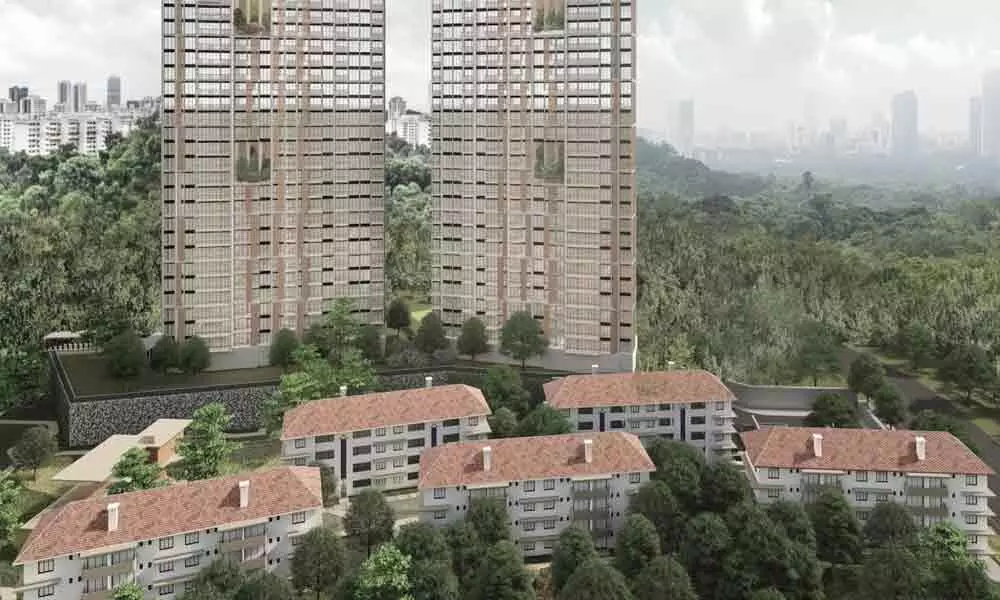Live
- DK Shivakumar Blends Political Confidence With Divine Intervention In Karnataka By-Elections
- Tamil Nadu Law And Order Crisis: Opposition Intensifies Attack On DMK Government
- Kerala CM Vijayan Rallies MPs To Press Centre On Pending State Demands
- Ramoji Group Donates ₹30 Crore to Indian School of Business (ISB)
- Celebrating the power of thought
- President Droupadi Murmu Arrives in Hyderabad to Attend Koti Deepotsavam
- Border-Gavaskar Trophy 2024-25: Rohit Sharma to join Indian team midway of Perth Test, set to be available from second Ind vs Aus Test
- Scholarships For Students
- EFLU hosts talk on 75 years of the Indian Constitution
- Mohan Babu: Half a Century of Cinematic Brilliance and Unwavering Legacy
Just In
World's tallest prefab towers to stand in Singapore but made in Malaysia


A pair of tall towers will become the tallest pre-fab buildings in the world.
This project will overtake Singapore's and the world's current tallest prefab, the two 192-meter-high (630-foot) towers will stand in Singapore.
A pair of tall towers will become the tallest pre-fab buildings in the world.
And while the two 192-meter-high (630-foot) towers will stand in densely populated Singapore, much of the structures are being built over the Malaysian border.
The residential project, called Avenue South Residences, will see 988 apartments made up of nearly 3,000 "modules" stacked vertically. The firm behind the project, ADDP Architects, says the construction method, known as Precast Precast Volumetric Construction (PPVC), requires less labour and can help reduce waste and noise pollution.
The individual modules are manufactured at the factory in Senai, Malaysia, where a series of six-sided boxes are cast in concrete. The units are then transported to a facility in Singapore to be fitted and furnished before being moved to the construction site.
By the time they arrive, the boxes are 80% complete, according to ADDP Architects. They are then lifted into position by a crane and "sewn" together to form a strong frame that supports the load, said one of the company's associate partners, Markus Cheng Thuan Hann. Finishing touches, like doors, are added later, the architect said.
"It's like a car manufacturing concept, but for the building industry," he added in a phone interview.
Benefits of prefabrication
Controlling the amount of construction work carried out at the site located in Singapore's residential Bukit Merah district can help lessen disruption to those living nearby, Hann said.
"But this construction (method) really helps to reduce noise," he said, of the benefit to the surrounding public housing estates. "And it can reduce waste... because the workmanship in a factory is much better controlled."
Another unexpected benefit has developed in the light of Covid-19: Less labour is needed at the construction site at any one time. "It's easier to control safe distancing and logistical planning in the factory, rather than having all the (workers) on-site," Hann pointed out.
During the post-war period, the prefabrication industry first boomed in Europe and America, with urban planners using it to quickly and affordably address housing shortages. But the prefabs is now increasingly dominated by the Asia-Pacific region.
The building method has become very popular in Singapore, with the country's Building and Construction Authority actively encouraging the use of PPVC, citing an 8% cost saving and a 40% boost in productivity versus traditional construction means (it credits the latter to more productive "manpower," and "time savings"). Since 2014, the agency has even made prefabrication a requirement for certain sites.
Construction on Avenue South Residences has already started, and the developers aim to finish the project by the first quarter of 2023. This project will overtake Singapore's and the world's current tallest prefab, the 140-meter-high (459 feet) Clement Canopy, which was also designed by ADDP Architects. Among the world's other tallest modular buildings is a 135-meter (443 feet) tower in Croydon, South London, and a 109-meter (359 feet) residential development in New York.

© 2024 Hyderabad Media House Limited/The Hans India. All rights reserved. Powered by hocalwire.com






